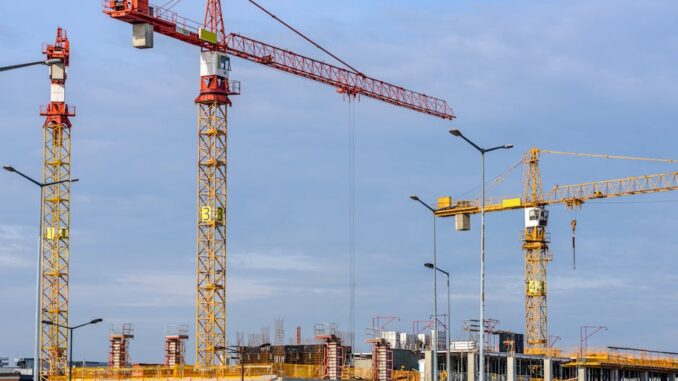
Summary
This article provides actionable steps to achieve a BREEAM Outstanding rating, focusing on spatial arrangement in London. It examines how spatial factors interact with BREEAM principles, offering insights for sustainable urban development. By following these steps, developers can contribute to an environmentally and socially responsible built environment.
Air quality is vital in planning. See how Focus360 Energy can assist.
** Main Story**
Designing for BREEAM Outstanding in London: A Spatial Approach
So, you’re aiming for BREEAM Outstanding in London? That’s ambitious, but definitely achievable! It represents the gold standard in sustainable building, and honestly, it’s a worthwhile goal. This guide provides a framework, focusing on how spatial design plays a critical role in getting you there.
Step 1: Early BREEAM Integration and Site Selection
First things first, bake BREEAM considerations into the project from day one. Choosing the right site is paramount. Think about it, you can’t really build a sustainable building on an unsustainable site, right?
- Connectivity: Location, location, location! Prioritize sites with fantastic public transport links. London’s got a pretty impressive network, so make the most of it! Encouraging sustainable commuting is a big win and cuts down on reliance on cars. That’s more points in the ‘Transport’ category.
- Existing Amenities: Nearby shops, restaurants, parks…they all matter. You don’t want to have to build everything from scratch; leverage what’s already there to promote walking and cycling. It’s better for the environment, sure, but it’s also better for the people who will use the building.
- Brownfield Redevelopment: Look, I get it, brownfield sites can be tricky. But reusing them, well, that’s brilliant! It minimizes environmental impact and helps breathe new life into urban areas. Plus, points, points, points!
Step 2: Mastering Spatial Design for Sustainability
Spatial design isn’t just about aesthetics; it’s about performance and well-being. Get this right, and you’re halfway there.
- Passive Design Strategies: Natural light and ventilation are your friends. Orient the building to maximize sunlight, position windows strategically, and use shading to control heat. London’s climate, whilst known for its gloom, can actually be leveraged for some decent passive design – reducing reliance on those energy-guzzling mechanical systems.
- Green Infrastructure: Green roofs? Yes! Green walls? Absolutely! Urban landscaping? A must! They boost biodiversity, manage stormwater, and clean the air. Seriously, these aren’t just pretty features; they earn serious points in the ‘Land Use and Ecology’ category. Plus, imagine looking out of the window, its a lot nicer to see some plants than a concrete jungle, right?
- Spatial Efficiency: Design spaces that are flexible and adaptable. Think ahead! Minimizing the need for future renovations extends the building’s lifespan. My old office? It was a nightmare to reconfigure; wasted space everywhere. Don’t make that mistake!
Step 3: Embracing Innovation
Don’t be afraid to push boundaries. This is where you can really shine.
- Smart Building Technologies: Smart metering, BMS (Building Management Systems)…embrace the tech! Monitor and optimize energy and water usage. It’s all about data-driven decisions.
- Renewable Energy Integration: Solar panels, wind turbines, ground source heat pumps…Explore it all. London often incentivizes renewable energy, so it can actually be more affordable than you think.
- Circular Economy Principles: Use recycled materials, and design for disassembly and reuse. Minimizing waste is key. That means thinking about the entire lifecycle of the building materials.
Step 4: Collaboration and Expertise
You can’t do this alone. Trust me, I’ve tried. Teamwork makes the dream work, as they say.
- BREEAM Assessor Involvement: Get a licensed BREEAM assessor on board ASAP. Their expertise is invaluable. It ensures compliance and helps you maximize those sweet, sweet credits. Don’t try and do this alone, get a professional who knows the ins and outs.
- Interdisciplinary Teamwork: Architects, engineers, contractors…they all need to be on the same page. A holistic approach is the only way to truly achieve sustainability.
- Stakeholder Engagement: Listen to the local community. Incorporate their feedback. Make sure the project aligns with local needs. I once worked on a project where we completely missed the mark because we didn’t consult with the neighbors. Big mistake.
Step 5: Documentation and Certification
Paperwork. Ugh, I know. But it’s essential. Be meticulous!
- Pre-Assessment: Identify potential challenges early. Refine the design accordingly.
- Evidence Collection: Gather every single piece of evidence to prove compliance. No cutting corners here.
- Final Assessment: Submit everything for final review and certification. Fingers crossed!
With this comprehensive approach, you’ll have a much better chance of achieving BREEAM Outstanding in London, I’m sure. So, by understanding the link between spatial design and sustainable design, you can do your bit to contribute to a greener, healthier, and more environmentally sound urban place for everyone!


The emphasis on brownfield redevelopment is insightful, particularly regarding breathing new life into urban areas. Could you elaborate on successful strategies for mitigating potential contamination risks associated with such sites?
That’s a great point! Mitigating contamination risks is absolutely crucial. Thorough site investigations and risk assessments are the first step, followed by tailored remediation strategies. These can range from soil vapor extraction to capping and containment, depending on the specific contaminants present. It is important to note that early engagement with regulatory bodies can assist greatly with brownfield redevelopment.
Editor: FocusNews.Uk
Thank you to our Sponsor Focus 360 Energy
The emphasis on integrating BREEAM from the outset is key. Exploring how digital twins can simulate building performance early in the design phase to optimize spatial arrangements could further enhance sustainability outcomes.